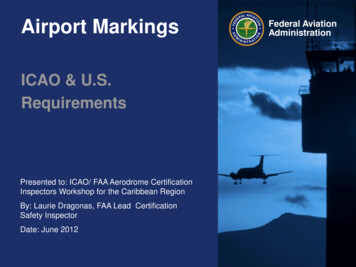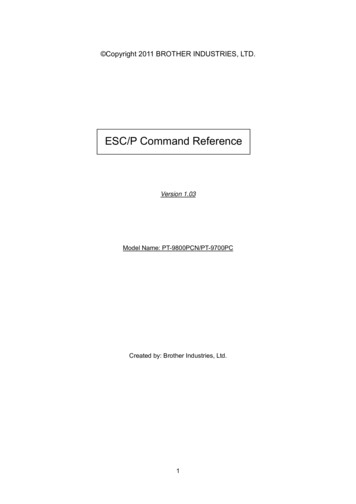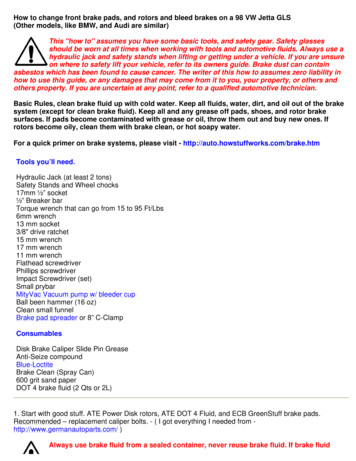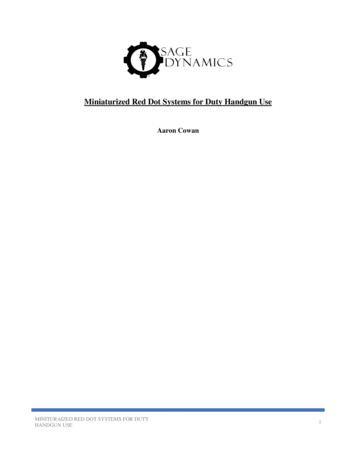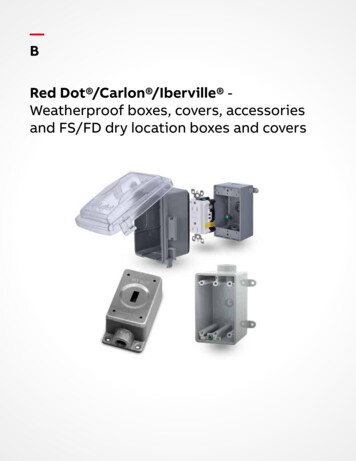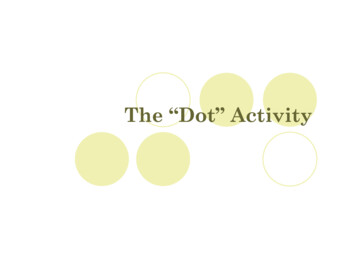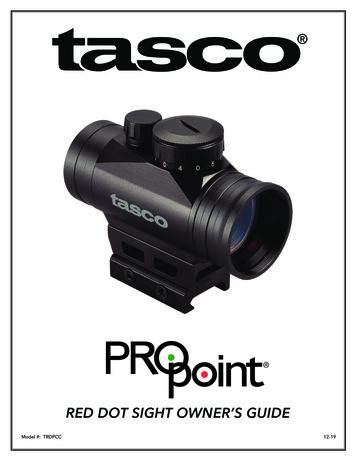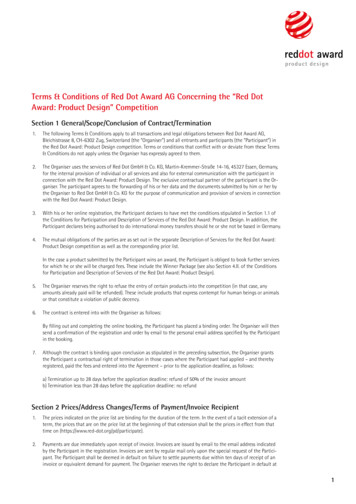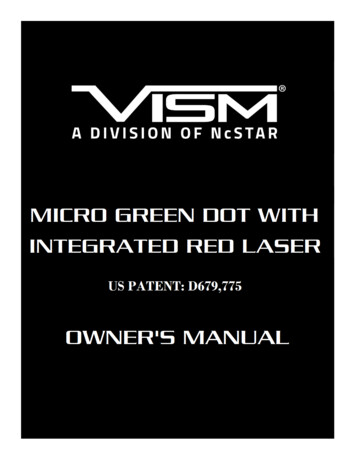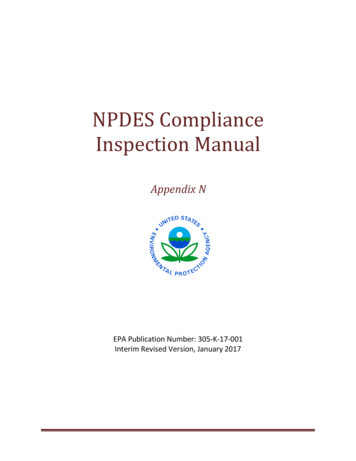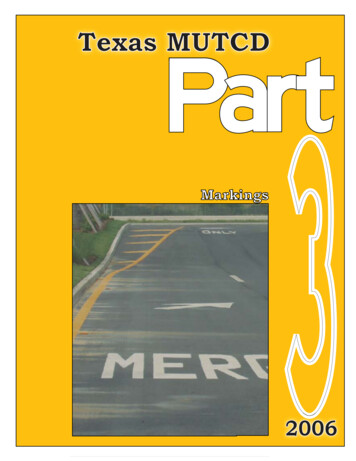
Transcription
2006 EditionPage TC3-1PART 3. MARKINGSTABLE OF CONTENTSPageSECTIONSCHAPTER 3A.GENERALSection 3A.01Section 3A.02Section 3A.03Section 3A.04Section 3A.05Functions and Limitations.3A-1Standardization of Application.3A-1Materials.3A-1Colors .3A-2Widths and Patterns of Longitudinal Pavement Markings .3A-2CHAPTER 3B.PAVEMENT AND CURB MARKINGSSection 3B.01Section 3B.02Section 3B.03Section 3B.04Section 3B.05Section 3B.06Section 3B.07Section 3B.08Section 3B.09Section 3B.10Section 3B.11Section 3B.12Section 3B.13Section 3B.14Section 3B.15Section 3B.16Section 3B.17Section 3B.18Section 3B.19Section 3B.20Section 3B.21Section 3B.22Section 3B.23Section 3B.24Section 3B.25Section 3B.26Section 3B.27Yellow Centerline Pavement Markings and Warrants.3B-1No-Passing Zone Pavement Markings and Warrants .3B-1Other Yellow Longitudinal Pavement Markings .3B-5White Lane Line Pavement Markings and Warrants .3B-7Other White Longitudinal Pavement Markings .3B-12Edge Line Pavement Markings .3B-17Warrants for Use of Edge Lines.3B-17Extensions Through Intersections or Interchanges .3B-17Lane Reduction Transition Markings.3B-20Approach Markings for Obstructions.3B-20Raised Pavement Markers .3B-24Raised Pavement Markers as Vehicle Positioning Guides with Other LongitudinalMarkings.3B-24Raised Pavement Markers Supplementing Other Markings .3B-25Raised Pavement Markers Substituting for Pavement Markings.3B-25Transverse Markings .3B-26Stop and Yield Lines .3B-26Crosswalk Markings.3B-27Parking Space Markings.3B-29Pavement Word and Symbol Markings.3B-29Speed Measurement Markings .3B-39Curb Markings.3B-39Preferential Lane Word and Symbol Markings.3B-40Preferential Lane Longitudinal Markings for Motor Vehicles.3B-40DELETED .3B-41DELETED .3B-41Speed Hump Markings.3B-41Advance Speed Hump Markings.3B-46CHAPTER 3C.OBJECT MARKERSSection 3C.01Section 3C.02Section 3C.03Section 3C.04Object Marker Design and Placement Height.3C-1Markings for Objects in the Roadway .3C-1Markings for Objects Adjacent to the Roadway .3C-1End-of-Roadway Markers .3C-3
Page TC3-22006 EditionCHAPTER 3D.ROADWAY DELINEATIONSection 3D.01Section 3D.02Section 3D.03Section 3D.04Delineators .3D-1Delineator Design.3D-1Delineator Application .3D-1Delineator Placement and Spacing .3D-3Section 3D.05Section 3D.06Barrier Reflectors.3D-5Chevrons .3D-6CHAPTER 3E.COLORED PAVEMENTSSection 3E.01General.3E-1CHAPTER 3F.BARRICADES AND CHANNELIZING DEVICESSection 3F.01Section 3F.02Barricades .3F-1Channelizing Devices .3F-1CHAPTER 3G.ISLANDSSection 3G.01Section 3G.02Section 3G.03Section 3G.04Section 3G.05Section 3G.06General .3G-1Approach-End Treatment .3G-1Island Marking Application .3G-1Island Marking Colors .3G-1Island Object Markers .3G-2Island Delineators.3G-2CHAPTER ectionSectionGeneral .3H-1White Lane Line Pavement Markings for Roundabouts.3H-1Edge Line Pavement Markings for Roundabouts.3H-1Yield Lines for Roundabouts .3H-1Crosswalk Markings at Roundabouts.3H-2Pavement Word and Symbol Markings for Roundabouts .3H-2Example Markings for Roundabouts .3H-33H.013H.023H.033H.043H.053H.063H.07CHAPTER 3I.MARKINGS FOR OTHER CIRCULAR INTERSECTIONSSection 3I.01General.3I-1FIGURESCHAPTER 3B.PAVEMENT AND CURB MARKINGSFigure 3B-1Figure 3B-2Figure 3B-3Figure 3B-4Examples of Two-Lane, Two-Way Marking Applications.3B-2Examples of Four-or-More Lane, Two-Way Marking Applications.3B-3Examples of Three-Lane, Two-Way Marking Applications .3B-4Example of Three-Lane, Two-Way Marking for Changing Direction of theCenter Lane .3B-6Method of Locating and Determining the Limits of No-Passing Zones at Curves .3B-8Example of Reversible Lane Marking Application.3B-9Example of Two-Way Left-Turn Lane Marking Applications.3B-10Figure 3B-5Figure 3B-6Figure 3B-7Figure 3B-7A.Example of White Solid Lines used to Prohibit Turning Movements within Ramp .3B-11Figure 3B-8Figure 3B-9Figure 3B-10Figure 3B-11Figure 3B-12Figure 3B-13Examples of Channelizing Line Applications for Exit Ramp Markings .3B-13, 14Examples of Channelizing Line Applications for Entrance Ramp Markings.3B-15Example of Lane Drop Markings at Exit Ramps.3B-16Examples of Extensions through Intersections .3B-18, 19Examples of Lane Reduction Markings.3B-21Examples of Markings for Obstructions in the Roadway.3B-22, 23
2006 EditionFigure 3B-14Figure 3B-15Figure 3B-16Figure 3B-17Figure 3B-18Figure 3B-19Figure 3B-20Figure 3B-21Figure 3B-22Figure 3B-23Figure 3B-24Figure 3B-25Figure 3B-26Figure 3B-27Figure 3B-28Figure 3B-29Figure 3B-30Page TC3-3Examples of Yield Line Layouts .3B-27Examples of Yield Lines at Unsignalized Midblock Crosswalks .3B-28Examples of Crosswalk Markings .3B-30Example of Crosswalk Markings for Exclusive Pedestrian Phase That PermitsDiagonal Crossing .3B-30Examples of Parking Space Markings .3B-31International Symbol of Accessibility Parking Space Marking with Blue Backgroundand White Border Options.3B-32Example of Elongated Letters for Word Pavement Markings .3B-32Examples of Standard Arrows for Pavement Markings.3B-33Examples of Lane Use Control Word and Symbol Markings .3B-35Examples of Arrow Markings at Exit Ramp Terminals.3B-36Examples of Arrow Markings at Entrance Ramp Terminals .3B-37Yield Ahead Triangle Symbols.3B-38Examples of Markings for Preferential Lanes .3B-43, 44DELETED.3B-45DELETED.3B-45Figure 3B-31Examples of Pavement Markings for Speed Humps Without Crosswalks .3B-45Examples of Pavement Markings for Speed Tables or Speed Humps withCrosswalks.3B-46Examples of Advance Warning Markings for Speed Humps .3B-47Figure 3B-32.Figure 3B-33.Parking Space Dimensions for 45 & 30 Angle Parking .3B-48Typical Accessible Parking Space Dimensions .3B-49CHAPTER 3C.OBJECT MARKERSFigure 3C-1Object Markers and End-of-Roadway Markers .3C-2CHAPTER 3D.ROADWAY DELINEATIONFigureFigureFigureFigureFigureExamples of Delineators .3D-1Suggested Spacing for Highway Delineators on Horizontal Curves .3D-4Suggested Spacing for Chevrons on Horizontal Curves .3D-4Barrier Reflectors.3D-5Reflector Installation .3D-63D-13D-23D-33D-43D-5CHAPTER 3H.ROUNDABOUTSFigure 3H-01Example of Markings for Approach and Circulatory RoadwayMarkings at a Roundabout .3H-2Examples of Markings for Pedestrian Crosswalks at a Roundabout .3H-3Example of Markings for One-lane Roundabout .3H-4Example of Markings for One-lane Roundabout with Dedicated Right-turn Lane .3H-5Example of Markings for Two-lane Roundabout with One and Two-lane Approaches,Option A.3H-6Example of Markings for Two-lane Roundabout with One and Two-lane Approaches,Option B.3H-7Example of Markings for Two-lane Roundabout with One-lane Exits .3H-8Example of Markings for Two-lane Roundabout .3H-9Example of Markings for Two-lane Roundabout with Double Left Turn .3H-10Example of Markings for Two-lane Roundabout with Double Right Turn,Option A .3H-11Example of Markings for Two-lane Roundabout with Double Right Turn,Option B.3H-12Example of Markings for Two-lane Roundabout with Consecutive Double Lefts.3H-13Example of Markings for Three-lane Roundabout with Two andThree-lane Approaches .3H-14Example of Markings for Three-lane Roundabout with Three-lane Approaches AFigure AFigure 3H-09BFigure 3H-10Figure 3H-11Figure 3H-12
Page TC3-4Figure 3H-13Figure 3H-14Figure 3H-152006 EditionExample of Markings for Three-lane Roundabout with Two-lane Exits .3H-16Example of Markings for Diamond Interchange with Two RoundaboutRamp Terminals.3H-17Example of Markings for Two Linked Roundabouts.3H-18TABLESCHAPTER 3B.PAVEMENT AND CURB MARKINGSTable 3B-1Table 3B-2Minimum Passing Sight Distances.3B-7Standard Edge Line Lane Markings for Preferential Lanes .3B-42CHAPTER 3D.ROADWAY DELINEATIONTable 3D-1Table 3D-2Table 3D-3Uses of Delineators .3D-2Approximate Spacing for Delineators on Horizontal Curves .3D-3Guidelines for Use of Warning Devices at Curves with Advisory Speed Limits .3D-4
2006 EditionPage 3A-1CHAPTER 3A. GENERALSection 3A.01 Functions and LimitationsSupport:Markings on highways have important functions in providing guidance and information for the road user.Major marking types include pavement and curb markings, object markers, delineators, colored pavements,barricades, channelizing devices and islands. In some cases, markings are used to supplement other trafficcontrol devices such as signs, signals and other markings. In other instances, markings are used alone toeffectively convey regulations, guidance, or warnings in ways not obtainable by the use of other devices.Markings have limitations. Visibility of the markings can be limited by snow, debris, and water on oradjacent to the markings. Marking durability is affected by material characteristics, traffic volumes, weather, andlocation. However, under most highway conditions, markings provide important information while allowingminimal diversion of attention from the roadway.Pavement markings can enhance roadway delineation with the addition of audible and tactile features such asbars, differential surface profiles, raised pavement markers, or other devices intended to alert the road user that adelineation on the roadway is being traversed.The general functions of longitudinal lines are:A. A double line indicates maximum or special restrictions,B. A solid line discourages or prohibits crossing (depending on the specific application),C. A broken line indicates a permissive condition, andD. A dotted line provides guidance.Section 3A.02 Standardization of ApplicationStandard:Each standard marking shall be used only to convey the meaning prescribed for that marking in thisManual. When used for applications not described herein, markings shall conform in all respects to theprinciples and standards set forth herein.Guidance:Before any new highway, paved detour, or temporary route is opened to traffic, all necessary markings shouldbe in place.Standard:Markings that are no longer applicable for roadway conditions or restrictions and that might causeconfusion for the road user shall be removed or obliterated to be unidentifiable as a marking as soon aspractical. Markings that must be visible at night shall be retroreflective unless ambient illuminationassures that the markings are adequately visible.Option:Markings may be temporarily masked with tape until they can be removed or obliterated.Section 3A.03 MaterialsSupport:Pavement and curb markings are commonly placed by using paint, or thermoplastics; however, other suitablemarking materials, including raised pavement markers and colored pavements, are also used. Delineators, objectmarkers, barricades, and channelizing devices are visibly placed in a vertical position similar to signs above theroadway.Guidance:The materials used for markings should provide the specified color throughout their useful life.Consideration should be given to selecting pavement marking materials that will minimize tripping or loss oftraction for pedestrians and bicyclists.Object markers and delineators should not present a vertical or horizontal clearance obstacle for pedestrians.
Page 3A-22006 EditionSection 3A.04 ColorsStandard:Markings shall be yellow, white, red, or blue. The colors for markings shall conform to the standardhighway colors. Black in conjunction with one of the above colors shall be a usable color.When used, white markings for longitudinal lines shall delineate:A. The separation of traffic flows in the same direction.B. The right edge of the roadway.When used, yellow markings for longitudinal lines shall delineate:A. The separation of traffic traveling in opposite directions.B. The left edge of the roadways of divided and one-way highways and ramps.C. The separation of two-way left turn lanes and reversible lanes from other lanes.When used, red raised pavement markers shall delineate roadways that shall not be entered or used.When used, blue markings shall supplement white markings for parking spaces for persons withdisabilities. When used, blue raised pavement markers shall indicate locations of fire hydrants along aroadway.Option:Black may be used in combination with the above colors where a light-colored pavement does not providesufficient contrast with the markings.Appropriate colors may be used for a route shield pavement marking symbol (i.e. red, white andblue for Interstate Highway Route Shield).Support:When used in combination with other colors, black is not considered a marking color, but only a contrastenhancing system for the markings.Section 3A.05 Widths and Patterns of Longitudinal Pavement MarkingsStandard:The widths and patterns of longitudinal lines shall be as follows:A. A normal line is 4 to 6 inches wide.B. A wide line is at least twice the width of a normal line. The width of the line indicates the degreeof emphasis.C. A double line consists of two parallel lines separated by a discernible space.D. A broken line consists of normal line segments separated by gaps.E. A dotted line shall consist of noticeably shorter line segments separated by shorter gaps than usedfor a broken line. The width of a dotted line shall be at least the same as the width of the line itextends.Guidance:Broken lines should consist of 10 ft. line segments and 30 ft. gaps, or dimensions in a similar ratio of linesegments to gaps as appropriate for traffic speeds and need for delineation.Option:A dotted line for line extensions may consist of 2 ft. line segments and 2 ft. to 6 ft. gaps. A dotted line forlane drop/add markings may consist of 3 ft. line segments and 12 ft. gaps.
2006 EditionPage 3B-1CHAPTER 3B. PAVEMENT AND CURB MARKINGSSection 3B.01 Yellow Centerline Pavement Markings and WarrantsStandard:Centerline pavement markings, when used, shall be the pavement markings used to delineate theseparation of traffic lanes that have opposite directions of travel on a roadway and shall be yellow.Option:Centerline pavement markings may be placed at a location that is not the geometric center of the roadway.On roadways without continuous centerline pavement markings, short sections may be marked withcenterline pavement markings to control the position of traffic at specific locations, such as around curves, overhills, on approaches to highway-railroad grade crossings, at highway-railroad grade crossings, and at bridges.Standard:The centerline markings on two-lane, two-way roadways shall be one of the following as shown inFigure 3B-1:A. Two-direction passing zone markings consisting of a normal broken yellow line where crossing thecenterline markings for passing with care is permitted for traffic traveling in either direction;B. One-direction no-passing zone markings consisting of a normal broken yellow line and a normalsolid yellow line where crossing the centerline markings for passing with care is permitted for thetraffic traveling adjacent to the broken line, but is prohibited for traffic traveling adjacent to thesolid line; andC. Two-direction no-passing zone markings consisting of two normal solid yellow lines where crossingthe centerline markings for passing is prohibited for traffic traveling in either direction.The centerline markings on undivided two-way roadways with four or more lanes for moving motorvehicle traffic always available shall be the two-direction no-passing zone markings consisting of twonormal solid yellow lines as shown in Figure 3B-2.Guidance:On two-way roadways with three through lanes for moving motor vehicle traffic, two lanes should bedesignated for traffic in one direction by using one- or two-direction no-passing zone markings as shown inFigure 3B-3.Standard:Centerline markings shall be placed on all paved urban arterials and collectors that have a traveledway of 20 ft. or more in width and an ADT of 6,000 vehicles per day or greater. Centerline markings shallalso be placed on all paved two-way streets or highways that have three or more lanes for moving motorvehicle traffic.Guidance:Centerline markings should be placed on paved urban arterials and collectors that have a traveled way of 20ft. or more in width and an ADT of 4,000 vehicles per day or greater. Centerline markings should also be placedon all rural arterials and collectors that have a traveled way of 18 ft. or more in width and an ADT of 3,000vehicles per day or greater. Centerline markings should also be placed on other traveled ways where anengineering study indicates such a need.Engineering judgment should be used in determining whether to place centerline markings on traveled waysthat are less than 16 ft. wide because of the potential for traffic encroaching on the pavement edges, traffic beingaffected by parked vehicles, and traffic encroaching into the opposing traffic lane.Option:Centerline markings may be placed on other paved two-way traveled ways that are 16 ft. or more in width.If a traffic count is not available, the ADTs described in this Section may be estimates that are based onengineering judgment.Section 3B.02 No-Passing Zone Pavement Markings and WarrantsStandard:No-passing zones shall be marked by either the one direction no-passing zone pavement markings orthe two-direction no-passing zone pavement markings described previously and shown in Figures 3B-1 and3B-3.
Page 3B-22006 EditionFigure 3B-1. Examples of Two-Lane, Two-Way Marking Applicationsa - Typical two-lane, two-way markingwith passing permitted in both directionsb - Typical two-lane, two-way markingwith no passing zonesLegendDirection of travelNote:See Section 3B.07for edge line warrants.NopassingzoneNopassingzone
2006 EditionPage 3B-3Figure 3B-2. Examples of Four-or-More Lane, Two-Way Marking Applicationsa - Typical multi-lane,two-way markingb - Typical multi-lane, two-way markingwith single lane left turn channelizationLegendOptionalDirection of travelNote:See Section 3B.07for edge line warrants.
Page 3B-42006 EditionFigure 3B-3. Examples of Three-Lane, Two-Way Marking Applicationsa - Typical three-lane, two-waymarking with passing permittedin single-lane directionb - Typical three-lane, two-waymarking with passing prohibitedin single-lane directionLegendDirection of travel
2006 EditionPage 3B-5When centerline markings are used, no-passing zone markings shall be used on two-way roadways atlane reduction transitions (see Section 3B.09) and on approaches to obstructions that must be passed onthe right (see Section 3B.10).Guidance:Where the distance between successive no-passing zones is less than 400 ft., no-passing markings shouldconnect the zones.Standard:Where centerline markings are used, no-passing zone markings shall be used on approaches tohighway-rail grade crossings in conformance with Section 8B.20.Option:In addition to pavement markings, no-passing zone signs (see Sections 2B.29, 2B.30, and 2C.35) may beused to emphasize the existence and extent of a no-passing zone.Standard:On two-way, two- or three-lane roadways where centerline markings are installed, no-passing zonesshall be established at vertical and horizontal curves and other locations where an engineering studyindicates that passing must be prohibited because of inadequate sight distances or other special conditions.On three-lane roadways where the direction of travel in the center lane transitions from one directionto the other, a no-passing buffer zone shall be provided in the center lane as shown in Figure 3B-4. A lanetransition shall be provided at each end of the buffer zone.The buffer zone shall be a median island that is at least 50 ft. in length.Guidance:For three-lane roadways having a posted or statutory speed limit of 45 mph or greater, the lane transitiontaper length should be computed by the formula L WS for speeds in mph. For roadways where the posted orstatutory speed limit is less than 45 mph, the formula L WS ²/60 for speeds in mph should be used to computetaper length. Under both formulas, L equals the taper length in feet, W equals the width of the center lane oroffset distance in feet, and S equals the 85th-percentile speed or the posted or statutory speed limit, whichever ishigher.Standard:The minimum lane transition taper length shall be 100 ft. in urban areas and 200 ft. in rural areas.On roadways with centerline markings, no-passing zone markings shall be used at horizontal orvertical curves where the passing sight distance is less than the minimum necessary for reasonably safepassing at the 85th-percentile speed or the posted or statutory speed limit as shown in Table 3B-1. Thepassing sight distance on a vertical curve is the distance at which an object 3.5 ft. above the pavementsur
Section 3A.04 Colors Standard: Markings shall be yellow, white, red, or blue. The colors for markings shall conform to the standard highway colors.
